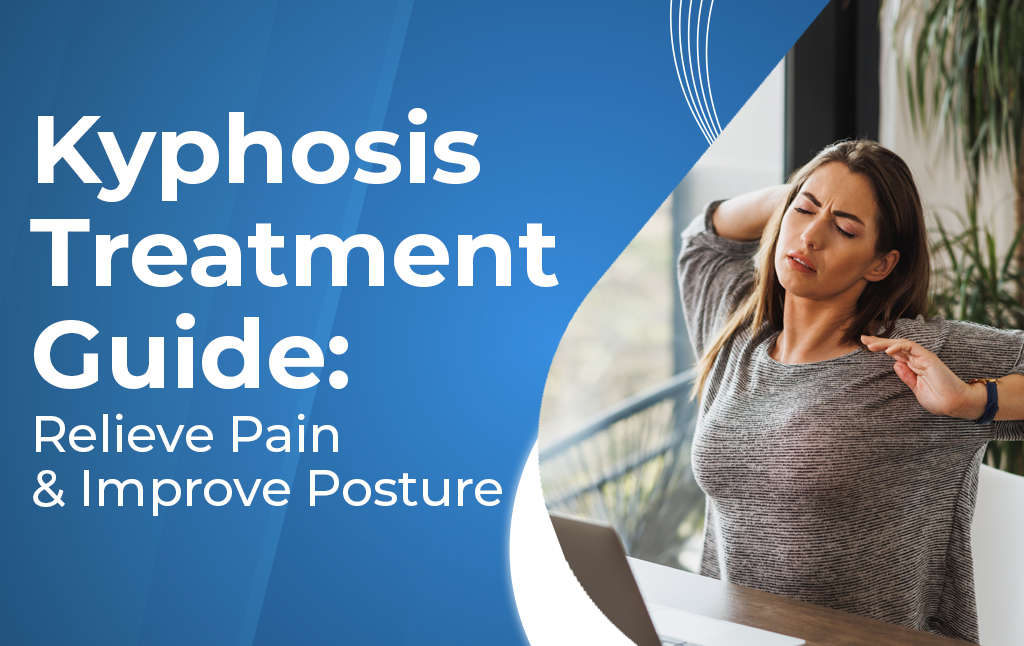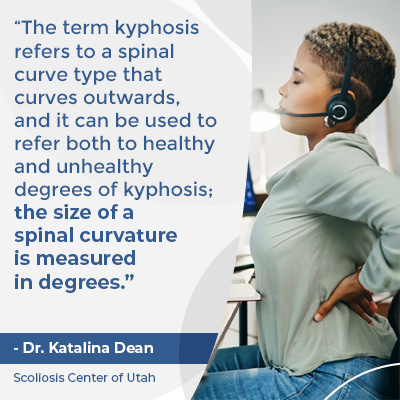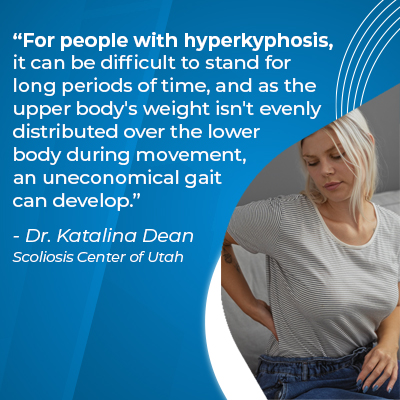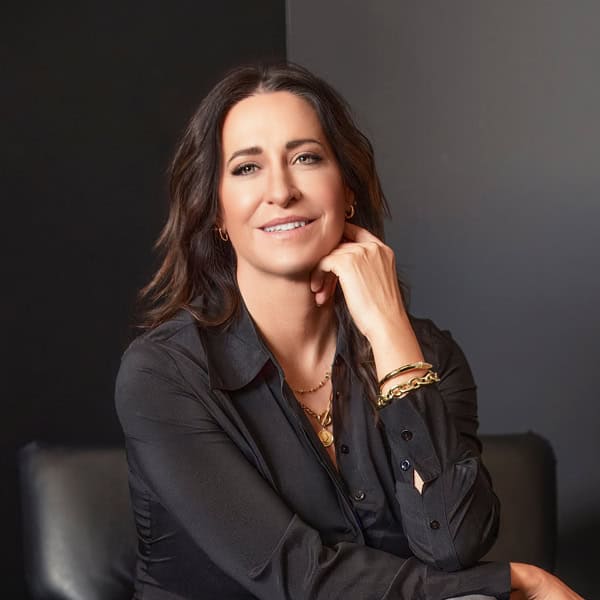Blogs
Kyphosis Treatment Guide: Relieve Pain & Improve Posture

Unnatural spinal curves can disrupt the spine’s overall balance, stability, and function. While the loss of a healthy curve to a small degree may not cause noticeable symptoms, the more excessive an unnatural spinal curve is, the more noticeable its effects are likely to be.
Kyphosis is a type of spinal curve that curves outwards, and the spine’s natural kyphosis is found in the thoracic spine. If a person’s degree of kyphosis becomes excessive, the curve can become problematic by disrupting posture, movement, and causing pain.
Kyphosis that becomes excessive is diagnosed as hyperkyphosis, or simply referred to as kyphosis.
What is Kyphosis?
 The term kyphosis refers to a spinal curve type that curves outwards, and it can be used to refer both to healthy and unhealthy degrees of kyphosis; the size of a spinal curvature is measured in degrees.
The term kyphosis refers to a spinal curve type that curves outwards, and it can be used to refer both to healthy and unhealthy degrees of kyphosis; the size of a spinal curvature is measured in degrees.
The spine is naturally curved at each of its main sections, and the thoracic spine refers to the middle/upper back, is the largest spinal section, and is where the spine’s natural kyphosis occurs.
Each spinal section has unique roles to play in overall spinal function, and the thoracic spine is the only section that attaches to the rib cage, so helps anchor the rib cage, stabilizes the torso, and protects important organs (heart and lungs).
The thoracic spine also facilitates a wide range of movement in the upper body and protects the spinal nerves within, so if the thoracic spine’s healthy spinal curve is lost, its ability to perform optimally can be compromised.
The spine’s healthy curves make it stronger, more flexible, balanced, and able to handle stress from every-day life, and as the spinal sections are connected as one long structure, the health of one section can affect the others.
The size of healthy spinal curves can vary from person to person, but as long as a curvature falls within what’s considered a normal size range, the curve is considered healthy, but if a person’s kyphosis becomes excessive, it can be problematic and is considered an unhealthy spinal curve.
A healthy range of thoracic kyphosis is considered to fall between 20 and 40 degrees, with hyperkyphosis diagnosed commonly at 45+ degrees.
Hyperkyphosis Symptoms
While there can also be a loss of healthy kyphosis that involves the spine becoming excessively straight (hypokyphosis), hyperlordosis is more common.
When the spine curves outward excessively at the thoracic section, the main symptom is visual: postural changes.
What commonly develops is a rounded-forward posture with the upper back and shoulders arching noticeably, causing a slouching appearance.
Depending on the type of kyphosis in question, the curve can become larger over time, particularly in older adults and adolescents.
The most noticeable symptom is poor posture caused by the spine’s lack of balance and alignment disrupting the body’s overall symmetry and balance, but movement changes are also common as the upper body is less able to evenly distribute its weight over the lower body.
When the body isn’t balanced, it can cause the development of unhealthy movement patterns, and over time, this will cause uneven wear and tear on the spine and its individual structures.
Pain can develop, is more common in adults, and can include lower back and leg pain, spinal rigidity, and a limited range of motion.
 For people with hyperkyphosis, it can be difficult to stand for long periods of time, and as the upper body’s weight isn’t evenly distributed over the lower body during movement, an uneconomical gait can develop.
For people with hyperkyphosis, it can be difficult to stand for long periods of time, and as the upper body’s weight isn’t evenly distributed over the lower body during movement, an uneconomical gait can develop.
There are also different types of kyphosis, determined by its underlying cause, and this informs the customization of treatment plans.
Types of Thoracic Kyphosis
The main types of hyperkyphosis include postural kyphosis, Scheuermann’s kyphosis, and age-related kyphosis.
Postural kyphosis is the most prevalent type and is caused by chronic poor posture that, over time, strains the spine and its surrounding muscles and ligaments, causing a loss of spinal support and stability.
Postural kyphosis isn’t structural so is the simplest type to treat as the curve is flexible and can be altered by a change in position.
Scheuermann’s kyphosis is a structural condition so the spine is rigid and involves misshapen vertebrae causing the spine to wedge forward and develop excessive kyphosis.
Scheuermann’s kyphosis can get worse with growth and most often occurs during adolescence.
Age-related kyphosis is caused by natural age-related spinal degeneration, most of which starts with the spine’s intervertebral discs.
A disc sits between adjacent vertebrae providing cushioning, flexibility, structural support (adjacent vertebrae attach to the disc in between), and act as the spine’s shock absorbers, so if a single disc starts to degenerate, it can change shape, and this affects the position of vertebral bodies attached.
Age-related kyphosis can get worse as the spine becomes increasingly unbalanced and unstable, so this type is almost always painful and progressive.
Kyphosis Treatment Options
Kyphosis treatment plans need to be customized around a number of key variables such as condition severity, type, and experienced symptoms.
For postural kyphosis, in many cases, because it’s not a structural kyphosis, kyphosis-specific exercise can help correct posture and restore balance to the spine and body’s posture.
The use of mirror image exercises are valuable in teaching postural awareness so patients can actually learn how to position their bodies and move symmetrically and mindfully
Kyphosis-specific exercise can also target the thoracic spine’s surrounding muscle balance and strength, ensuring the spine is receiving optimal support.
Exercises that increase spinal flexibility and support will also help with pain management.
The way we hold our bodies and spines during daily activities is key to long-term spinal health, and restoring posture can improve the spine’s balance and stability.
For Scheuermann’s kyphosis that’s structural, the curve will be rigid and outside the scope of kyphosis-specific exercise alone, which is where corrective 3D bracing comes in.
For age-related kyphosis, fall prevention and pain management is a focus of treatment, and this is worked towards through muscle strengthening and improving the spine’s balance and stability.
KyphoBrace®
Any type of treatment that improves posture can benefit the spine. As one of the roles of the spine is to acclimate a straight and upright posture, spinal health is very connected to posture.
In fact, here at the Scoliosis Center of Utah, a patient’s initial assessment focuses on posture and movement; I can tell a lot about the health of a patient’s spine by observing their postural habits and movement patterns.
A kyphosis brace is a tight-fitting custom orthotic device that’s worn around the torso to apply pressure to the curve and improve its position, alignment, and balance.
Bracing can be a highly-effective nonsurgical treatment option for a variety of unhealthy spinal curves, and when it comes to excessive kyphosis, the KyphoBrace is a valuable treatment tool that complements kyphosis-specific physical therapy.
The KyphoBrace® is a 3D brace for addressing hyperkyphosis in children and adults, and it’s evidence-based and patient-centered.
For older patients, a brace can be essential for increasing spinal stability and short-term pain management; if there is too much instability in a spine, there is too much movement, and these patients are not only going to experience back and muscle pain, but are also at risk of injury through a fall.
A corrective brace that stabilizes the spine preventing excessive movement can help reduce pain and improve the patient’s overall stability.
The KyphoBrace® is corrective and works towards restoring a healthy degree of kyphosis for a patient’s age, and curve reductions will also improve posture and the body’s symmetrical appearance.
A brace that improves the spine’s alignment and 3-dimensional posture will also help restore the body’s alignment and balance, and as postural awareness is a focus of physical therapy, the corrections achieved can be sustained for long-term results.
Conclusion
Spinal health can shape quality of life in a number of ways from appearance to function.
A spine that’s balanced and stable can support a healthy symmetrical posture; one of the first signs a healthy spinal curve has been lost is asymmetrical posture.
Improving posture can mean improving the forces the spine and its surroundings are exposed to.
Spinal health also shapes the health of its surrounding muscles and nerves, and as the brain and spine work together as the central nervous system, spinal health also shapes brain-body communication.
Having good posture also facilitates healthy movement patterns; another symptom of unhealthy spinal curves are changes to movement and balance.
Kyphosis refers to an outward curvature of the spine that naturally occurs in the thoracic spine, and a typical range is considered to be between 20 and 40 degrees, with hyperkyphosis commonly diagnosed at 45+ degrees.
While severe and/or typical cases can be referred for surgical treatment, nonsurgical treatment options are proven, effective, and preserve the spine’s natural strength and function.
Through the application of kyphosis-specific exercise and corrective bracing, a patient’s posture can be improved, along with the spine’s surrounding muscles strength and balance, and curvature reductions mean addressing the structural nature of kyphosis for optimal spinal alignment, stability and pain relief.

Dr. Katalina Dean
Dr. Katalina Dean is the founder and clinical director of Scoliosis Center of Utah, in Midvale, UT. Her team specializes in posture correction, spinal rehabilitation, and non-invasive scoliosis care and bracing.
Call Today
Do You Qualify for Care?
Schedule an Appointment Below
